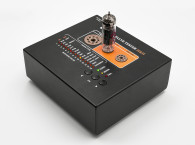
In my February 2016 article, I examined vacuum tube/valve testers, from the early filament continuity testers through the more advanced testers developed in the 1940s through the 1960s. These included four major categories of testers:
- Emission testers check for adequate quantities of electrons emitted from the cathode.
- Mutual conductance testers evaluate the transconductance (gm) of tubes, which is the gain, iplate/vgrid-to-cathode expressed in microsiemens.
- The dynamic conductance tester, which is a variation of the emission tester with similar advantages and disadvantages. This type of tester was made by several different manufacturers, and provided an indication related to transconductance, but not a true measurement of transconductance. The similarity of name (“dynamic conductance”, versus “mutual conductance”) was mainly designed to avoid infringing the patents and trademarks for the mutual conductance tester, held by Hickok Electrical Instrument Co.
- DC and AC parametric testers allowed the user to apply the DC and AC voltages to the tubes’ elements as required for measuring the tube parameters specified in a tube manual. Such testers were used mainly in laboratories in which new tube types were developed, and as QA testers for factories.
Vintage tube testers always included some sort of chart that would direct the user in setting up a test for a specific type of tube. The Sencore Mighty Mite tester (Photo 1) came with a booklet (Photo 2), detailing test setups for many types of tubes. Other manufacturers used similar booklets or roll charts (Photo 3).



Computerized Testers
In modern times, we now have computerized testers. “Computerized” can mean several things: Most people think of a computer as a device used for digital numeric processing, although the first computer was mechanical—similar to a very advanced adding machine.
But nowadays, most home appliances are computerized. The small microcontrollers function to automate repetitive processes, such as sequencing the cycle of a washing machine or setting control parameters for a microwave oven.
The Cardmatic line of tube testers were introduced in the 1950s by the Hickok Electrical instrument Co. (Photo 4). They were computerized in the sense that they used punched cards to activate the setup switches, not only automating the testing process, but allowing the test voltages to be set closer to the values in the tube manuals. Not only did this approach save time, but it allowed less well-trained technicians to make more accurate, repeatable measurements and eliminate mistakes. This line of testers was also produced for the military and for Western Electric (for use in telephone system maintenance). If memory serves, The Cardmatic tester weighed in at about 50 pounds.

Orange Amps introduced its VT1000 Valve Tester in 2012. This computerized unit was designed for testing tubes commonly used in electronic musical instrument amplifiers. It could test types EL34/6CA7, EL34L, 6L6; 6V6/6V6GTA, KT66, KT77, KT88, 6550, 5881, EL84/6BQ5, ECC81/12AT7, ECC82/12AU7, ECC83/12AX7, ECC99, and 12BH7. It could test for filament shorts, opens, leakage, and other abnormalities; amplification factor, voltage gain, power gain, screen grid operation, mutual conductance, a dual mutual conductance test for double triodes, inter-electrode leakage and shorts, flash-over, and gas ionization: the VT1000 performed a much more extensive set of tests than most of the previous testers on the market. In this easily portable tester, computerization employed a microcontroller to set test parameters, sequence the series of tests performed on each tube, compute results, and control the LED array on which test results were displayed.
My March 2016 Hollow-State Electronics article reviewed a computerized AC and DC parametric tester, the Amplitrex AT1000. While its extensive capabilities come at a commensurate price, this unit is easy to use, provides comprehensive tests of more than 600 types of tubes, and comes with software that permits the user to create characteristic curves of tubes under test, including parameter matching. It also allows the user to create custom tests for tube types not included in the database. While it provides a comprehensive set of testing options, the AT1000 is overkill for many hobbyists and users of hollow-state equipment.
In 2017, Chris Chang of Taiwan began development of a microcontroller-based tube tester and curve tracer, which he named the eTracer. This tester is similar in concept to the uTracer, but different in design and execution. The eTracer is available as a fully assembled and tested microcontroller board with the necessary computer software at a price of $880 USD. Options including chassis and power supply are also available, allowing the builder to customize his/her own completer tester.
The Orange Valve Tester MKII
Musicians and audiophiles who want to easily test the most common audio preamplifier and power tubes may be interested in the Orange Valve Tester MKII, released in February 2024. It shares many features with the VT1000 and can test any of 14 types of tubes common to musical instrument amplifiers: the EL34/6CA7, 6L6; 6V6/6V6GTA, KT66, KT77, KT88, KT120, 6550, 5881, EL84/6BQ5, ECC81/12AT7, ECC82/12AU7, ECC83/12AX7, ECC99, and 12BH7.
The Orange Amps website states that “the latest model of the Orange Valve Tester has greatly improved algorithms with an updated database containing the test results of literally hundreds of new, used, and faulty valves giving the MKII a much greater intelligence compared to the original Orange VT1000.
All the voltages required by the tester are internally derived, stabilized, and controlled, allowing a rapid static and transient testing without unnecessary heat generation.” Additional features include:
- New microphony function test (The microphony function test is for ECC81, ECC82, ECC83 & 12BH7 valves only)
- Capability to test directly heated valves with expansion modules
- All valves tested under higher current
- Improved test sockets
- More rugged design
- Capability to test other valve types such as rectifiers with expansion modules
- Valve failure mode fault indication
- The MKII is powered by a 19V, 3.42A power supply that comes in the box with the tester.

To test a tube, the user connects the power adapter to the wall outlet and to the tester and presses the OK button, then plugs the tube into the correct socket: OCTAL, EL84, or PREAMP, then uses the left and right arrow buttons to illuminate the LED corresponding to the type of tube being tested (Photo 5), then presses the OK button. During the next 2 minutes, the tube’s heater is powered up so that the tube warms up and various orange LEDs illuminate and flash. If the test fails at any time, the red FAIL LED illuminates and the test is terminated.
Once the test is complete, the green GOOD LED, the yellow WORN LED, or the red FAIL LED illuminates (Photo 6), indicating the condition of the tube. Units testing as WORN will still operate but should be replaced to prevent unpleasant surprises.

When the test is completed as GOOD, one of the orange LEDs will illuminate, indicating the relative gain of the tube. For dual-triode preamp tubes, one LED will illuminate solid, and another flashing. These indicate the gains of each triode section. If the gains are matched, only one LED will illuminate.
To test a preamp tube for microphonics, the user selects EXPANSION via the left and right arrow buttons, then holds the right-arrow button down for 3 seconds. The yellow LED will illuminate, indicating that the tube is warming up. When it goes out and the green button illuminates, the user can use a pencil (included with the tester) or other implement to tap the tube. The LEDs will act as a sort of level meter; the more LEDs that illuminate, the more microphonic the tube is. If LEDs illuminate when the tube is not being tapped, the tube is noisy.

Faults causing a tube to fail testing are indicated by the LED that illuminates along with the red FAIL LED. These faults are indicated in Figure 1. The GOOD/WORN/FAIL decision is made after 19 tests have been automatically performed on the tube. The tests are:
- Heater filament test: Short circuit
- Heater filament test: Open Circuit
- Heater filament test: Tolerance check
- Heater cathode insulation: Leakage
- Heater cathode insulation: Short Circuit
- Test for heater current abnormalities
- Amplification factor
- Voltage gain
- Power gain
- Screen grid test
- Mutual conductance test
- Dual test for double triodes
- Emission
- Inter Electrode leakage
- Inter electrode short circuit
- Flash-over (arc detection, high voltage breakdown)
- Gas ionization test
- New thermal runaway test
- New enhanced grid leakage detection test

Testing the Tester
I tested a selection of good new and used tubes and found the MKII tester to operate as easily and reliably as advertised. Interestingly, one new 12AX7A that I tested came up with matching numbers of 10 and 12, indicating significantly higher gain in one triode. This was an American-branded tube of Chinese manufacture.
New 6V6s tested GOOD, and a 6550 that I had replaced in a customer’s amplifier at the customer’s request also checked GOOD. Since that amplifier used six 6550s, if we had been able to check the old tubes before replacing them “on general principles,” the amp’s owner could have saved some cash!
Conclusions
Although designed for use by musicians and hifi enthusiasts rather than as a lab instrument, at 6½″×7½″×2½″, and weighing less than 5 pounds, the Orange Valve Tester MKII is reasonably priced, accurate, easy to pack, easy to carry, and easy to use, making it a valuable addition to any musician’s or audiophile’s collection of test instruments.
Supplied as a complete, assembled piece of test equipment, the Orange Valve Tester MKII can be put to work immediately upon receipt, without any need for assembly, programming, or tube model setup definitions. aX
This article was originally published in audioXpress, July 2024
Resources
C. Chang, “Etracer: The Vacuum Tube Curve Tracer,” essues Technologies Co., Ltd., www.essues.com/etracer/index.php/about
Orange Amps, https://orangeamps.com/products/accessories/amplifier-management/valve-tester
R. Honeycutt, “Amplitrex AT1000 Tube Tester,” audioXpress, March 2016.
R. Honeycutt, “Testing Tubes,” audioXpress, February 2016.
The μTracer: A Small but Powerful Tube Tester/Tube Curve-Tracer, https://www.dos4ever.com/uTracer3/uTracer3_pag0.html






